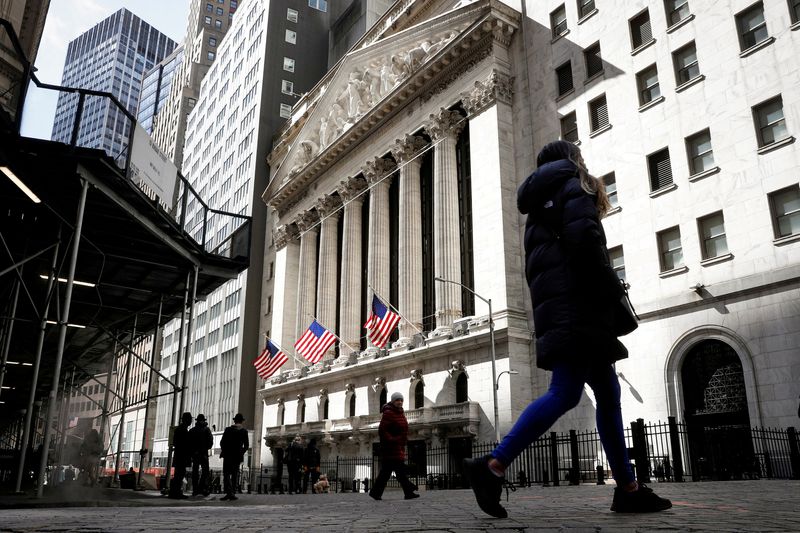Investors rethink recession plays, boosting U.S. stock market laggards
2023.06.09 18:01

© Reuters. FILE PHOTO: People are seen on Wall Street outside the New York Stock Exchange (NYSE) in New York City, U.S., March 19, 2021. REUTERS/Brendan McDermid
By David Randall
NEW YORK (Reuters) – A U.S. stocks rally is showing signs of expanding beyond the cluster of giant growth and tech names that have led gains this year, as investors reposition portfolios primed for a widely expected recession.
For months, investors piled into a handful of megacap companies seen as safe bets in uncertain times, spurring a rally that has lifted the nearly 12% year-to-date, concentrated in a small group of stocks.
As the U.S. economy holds up despite higher interest rates, fears of an imminent downturn are fading. Some investors have started dipping their toes into economically sensitive market areas that have been out of favor this year including small caps, energy shares and industrial stocks – all of which have seen hefty rallies in June.
“We’re seeing indications that the economy is going to be more resilient to headwinds,” said Tim Murray, a capital market strategist in T Rowe Price (NASDAQ:)’s multi-asset division. “There’s reason to believe that the pessimism we saw at the start of the year is giving way to a stronger-than-expected market.”
Murray has increased his allocation to small-cap stocks, which tend to be among the most direct beneficiaries of economic growth. The small cap index of small cap companies has surged 6.6% this month. The index is up 5.9% year-to-date.
Other rebounding segments in June include the S&P 500 energy sector, which has gained 6% this month and S&P 500 industrials, up 5.7%. Energy is down 7.6% year-to-date, while industrials have risen nearly 4%.
By contrast, the tech-heavy has gained about 2% this month – though the recent underperformance follows a nearly 33% year-to-date surge on excitement over developments in artificial intelligence.
A broadening equity rally would be a welcome development for many investors, who have worried about the market’s narrow leadership. Just seven stocks – Apple Inc (NASDAQ:), Microsoft Corp (NASDAQ:), Alphabet (NASDAQ:) Inc, Amazon.com Inc (NASDAQ:), Nvidia (NASDAQ:) Corp, Meta Platforms Inc (NASDAQ:), and Tesla (NASDAQ:) Inc – have been responsible for almost all of the S&P 500’s gains this year, data from S&P Dow Jones Indices showed.
“This kind of dominance is unusual but you’re starting to see it turn around,” said Howard Silverblatt, senior index analyst at S&P Dow Jones Indices.
Ten of the 11 S&P 500 sectors are firmer for the month to date, compared to only six for the year. An additional sign that investors are looking further afield can be seen in the market’s breadth: the percentage of S&P 500 stocks trading above their 200-day moving average stood at nearly 54% on Friday, up from a low of 38% in March. That is still off from the high of 76% reached in February, however.
Stronger-than-expected jobs growth and robust consumer spending have been among the data points that have bolstered investors’ economic outlook.
Among the firms revising recession forecasts were Goldman Sachs (NYSE:), which in the past week cut its probability of a recession in the next 12 months to 25% from 35%, while Nuveen’s Chief Investment Officer Saira Malik recently wrote that a “mild” recession has likely been delayed from late 2023 to sometime in 2024.
Investors in the coming week will be watching U.S. consumer price data on Tuesday for signs that the Fed’s rate hikes are continuing to cool inflation without badly hurting growth. The Fed concludes its two-day monetary policy meeting on Wednesday, and while most market participants expect the U.S. central bank to leave rates unchanged, many will also be gauging policymakers’ appetite for future tightening.
Some market watchers believe it is too early for economic optimism. Analysts at Capital Economics wrote on Thursday that the small-caps rally was likely premature, saying they expected softer growth in coming months. Jobless claims released on Thursday were higher than expected, a sign that the labor market could be cooling.
Others, however, are more optimistic. Max Wasserman, senior portfolio manager at Miramar Capital, has been increasing his positions in underperforming consumer stocks such as Starbucks Corp (NASDAQ:) and Target Corp (NYSE:), respectively down around 1% and 15% year-to-date. He expects restaurants and retailers to outperform as growth stabilizes in the second half of the year.
“That’s when we think we will be rewarded,” he said.








